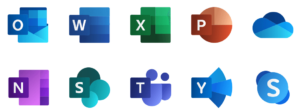What Really Is The Difference Between Office 365 and Microsoft 365?
We increasingly see references online to both Office 365 and Microsoft 365 – but what are they? Which one should you be using? What benefits do they deliver? And is there actually any difference between the two? Discover more in this post.
What is Office 365?
Office 365 is a Software as a Service (SaaS) solution that combines the traditional Microsoft Office desktop applications, Microsoft application services, and some new productivity services, all of which are enabled as consumable services from within Microsoft’s Azure cloud platform.
Launched by Microsoft back in June 2011, this subscription-based service is paid on either a monthly or annual basis providing an incredibly cost-effective way for organisations to consume their productivity workloads.
Office 365 contains the same core desktop applications as the traditional versions of Microsoft Office, such as Word, Excel, PowerPoint and Outlook, as well as a suite of other apps and online services for cloud file storage, secure communication, and collaboration. Tools such as Planner, OneDrive, Exchange, SharePoint, Yammer and Microsoft Teams all come together to provide an unparalleled user experience.
What is Microsoft 365?
A few months ago, on 21st April 2020, Microsoft officially rebranded Office 365, effectively changing the name from Office 365 to Microsoft 365 – but only for specific licence types – namely the small and medium business SKUs
.
Up until recently, Microsoft 365 was an enhanced variant of Office 365 that also included options for Windows 10 desktop licences, the Intune device management solution, and more – providing a true one-stop solution for organisations happy to put their faith entirely in Microsoft as a solution provider.
All applications included in the various versions Office 365 remain the same, along with service levels and subscription packages for current customers –it’s just the brand name that has changed.
This change is the opportunity for Microsoft to tie the powerful productivity features and services of Office 365 together with the platform-centric features of Microsoft 365, continuing the Microsoft progression of unifying its brands under fewer banners.
With the world in lockdown, this rebranding launch passed many of us by. However, the new brand name, Microsoft 365, is slowly being adopted and we anticipate to see more references to it as it starts to filter around the web. The official line from Microsoft is “Microsoft 365, formerly Office 365” and despite the rebrand, we expect to see the suite referred to as Office 365 for a while to come.
What’s the difference between Microsoft Office and Microsoft 365?
Microsoft brand names can be a little confusing. There has been a lot of “Office” and “Microsoft” bandied around over the years! Here’s a quick recap which describes the clear differences between them:
Microsoft Office (2013, 2016, 2019) are software suites which you purchase upfront, with a one-time perpetual licence, install on your computer and use for life. If you want to access the latest version, you have to buy a new copy of the latest edition to be able to use all the new features. And just so you know, Microsoft Office dates back nearly three decades, where early versions combined Word, Excel and PowerPoint into a discounted bundle.
Interestingly, as part of Microsoft’s evolution to subscription-based models, the latest versions of Office are now licensable on a subscription basis for all users. From single home use licences all the way up to the largest enterprises in the world, Office can now be bought as a subscription, whereas previously subscription pricing was only available to volume customers.
Microsoft 365, (which we now know was formerly Office 365), is the cloud-based service that requires a monthly or annual subscription to access all the Microsoft tools and apps hosted on Microsoft servers, including online versions of Microsoft Office – so there is no need to install it on your PC physically.
Built as a cloud-first service, but based on the on-premises products (such as SharePoint Server and Exchange Server), users always have access to the latest version, as the platform is regularly updated by Microsoft.
With several options for all-in-one subscriptions that include access to the Microsoft cloud services, Microsoft Office and Windows 10, Microsoft 365 will steadily become the de-facto licence for most organisations.
Why do businesses use Microsoft 365?
As it’s a cloud-based, subscription service, the software and services are automatically updated when a new version is released, so you always have access to the latest features and functionality. With updates being made almost constantly, you’re always up to date with features and patches, and there is no more waiting for updates on the three-year cycle Microsoft were historically famous for.
With services in the cloud, organisations don’t need to install server software or maintain any hardware on which to run it. This makes life a lot easier for the IT team where product updates, patches and new releases are issued automatically – and budget-friendly for the finance department.
A joint study commissioned by Microsoft and executed by Forrester Consulting revealed a 154 percent ROI for a small- to mid-sized company switching to Microsoft 365 in just over 5 months.
Microsoft 365 also comes with email hosting and cloud storage space, so users can save their documents to the cloud and access them wherever and whenever they need to, with secure access to content, conversations, tasks and schedules from any device.
Productivity tools help employees share knowledge, communicate better and effectively achieve more in a shorter time frame, and is where Microsoft 365 gets seriously smart.
All the apps and services in Microsoft 365 are connected, enabling enhanced teamwork and empowering employees to work better and faster together, through tools such as team chat, group emails, online meetings, as well as the co-authoring and sharing of files.
Improved collaboration and communication are vital components of productivity, and Microsoft 365 is proven to significantly reduce time spent on administrative tasks – for management, users and IT – so you can all focus on innovation to drive your business forward.
What are the pros of Microsoft 365?
- There are a number of benefits associated with using Microsoft 365:
- Improved collaboration and communication
- Greater productivity
- Anywhere access
- IT control & efficiency
- Automatic upgrades
- Ease IT burdens while increasing user desktop functionality
- Empower employees
What are the cons of Microsoft 365?
For Microsoft 365 to work, you always need an internet connection to access your data. No internet, no work.
Additionally, if your critical systems aren’t compatible with Microsoft 365, you may face some costly system upgrades prior to migration. Some organisations also struggle with data privacy – handing all your confidential data over to Microsoft – but there are workarounds and mitigations to retain some data on-site to fit with your own comfort levels.
However, the pitfall we see the most with Microsoft 365 in business is governance. From uncontrolled growth, stale content, compliance issues and complex provisioning of Microsoft Teams, Office 365 Groups and SharePoint, many organisations are struggling to maintain control of Microsoft 365.
We help users, management and IT administrators bring control, consistency and calm back to Microsoft 365. From preventing Teams sprawl to preserving content for compliance and simplifying provisioning, we can get Microsoft 365 governance sorted.
So, if you are looking to bring back control to administrators, self-service to users and peace of mind to management – get in touch.


